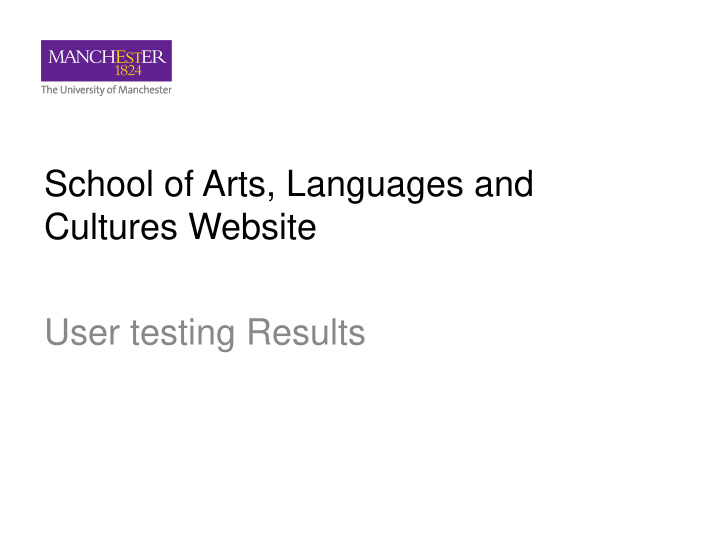



School of Arts, Languages and Cultures Website User testing Results
Background • User testing conducted throughout November 2012 • Three methods of assessment – ALC online staff survey – Random sampling – Web Ergonomics Lab
ALC Staff Survey • Survey ran for one week • Online select survey sent to 592 colleagues • 101 responses • Survey presented in three sections – Multiple choice scenarios – Direct questions – Open response questions (x2)
Staff Survey: Multiple Choice Scenarios (1) • 77 respondents • 24 skipped the questions Question Majority response Response % The site is clear and easy to navigate Agree 41% I am able to find the content I am looking for Agree 26% I can easily find my way around the site Agree 40% The design and structure is consistent and logical across Agree 36% the whole site The content is well written and easy to understand Agree/Neutral 40%
Staff Survey: Multiple Choice Scenarios (2) • 77 respondents • 24 skipped the questions Question Majority response Response % The text was confusing and contained too much jargon Disagree 49% There is too much text on the pages Neutral 39% There are enough images and video on the pages Neutral/Disagree 30% The images which are used within the site enhance the Disagree 30% written content and are visually appealing
Staff Survey: Direct questions (1) • 66 respondents • 35 skipped the questions Question Majority response Response % The ALC is visually engaging / attractive Yes 71% The overall site is visually engaging / attractive Yes/No 50% The typography used on the website (font size and Yes 80% style) is attractive and easy to read The colours used across the website (text, headings and Yes 76% images) are attractive The top navigation (tabs) are easy to understand and Yes 68% navigate around
Staff Survey: Direct questions (2) • 66 respondents • 35 skipped the questions Question Majority response Response % I prefer the rotating feature images over the static Yes 74% feature image When using the website, I can find the information I No 59% need quickly When using the website I generally know where I am Yes 55% within the structure and can easily navigate to other areas Each page has the right amount of information Yes 53% It is clear what content is aimed at different audiences No 55% (prospective students, research associates etc.)
Staff survey: Open responses (1) • Would you like to offer any further comment about the website? – 41 responses – 60 skipped the question • Main themes – Lack of engaging video/images – Text length – too long and inconsistent with other areas – Missing information from subject-area pages – ‘Our people’ page format – Greater use of bullet points to sell each subject – Use of ‘generic news’
Staff survey: Open responses (2) • If you could change anything on or about the website, what would it be? – 41 responses – 60 skipped the question • Main themes – More videos and images – Less text – Staff profiles (via Our people) – More key messages
Random sampling • Scenario based test • Designed by external agency in collaboration with Faculty Web Team and SALC colleagues • Sampling targeted volunteers from the Student Network – Recruitment facilitated by Student Marketing Communications Team – Adverts placed through a variety of Social Media channels • Sessions conducted by an external facilitator and Central marketing Team • Summary observation report produced by Central Marketing Team
Random sampling: Outcomes (1) 1. General look and feel • Students liked the design, professional and clean • No problem with horizontal and vertical navigation • Would prefer mega-menus for navigation • Students missed information beneath the fold – not willing to scroll • Students liked the ‘corporate look’ • Terminology in most tabs was well understood • Students didn’t interact with homepage features as they duplicated the tabbed navigation • ‘Browse our subjects’ box barely used
Random sampling: Outcomes (2) 1. Our people page • The natural destination for looking for academic staff information • Struggled to find individual academic research interests 2. Our research page • The natural destination for looking for research information • Struggled to find information on research topics, as pages tend to be ordered by research centres whose titles may not be clear • Participants directed to legacy sites which was confusing
Random sampling: Outcomes (3) 1. Subject area landing page • Subjects tab was the natural destination for subject information • Participants used link in left-hand navigation – Duplicate links within the body copy – Not appearing on mobile devices 2. Course information pages • Found course pages cluttered and confusing (Campus Solutions) • Participants directed to legacy sites for course modules – Caused confusion – Not clear if module information was still accurate
Random sampling: Outcomes (4) 1. Individual subject area pages • (Landing page) – Key links expected in body copy • Course lists – hard to find. Should also be an entry point in the copy • Landing page images – some participants drawn to them, others ignored them • Rotating slides – participants may not wait on the page long enough for to see the slide change
Recommendations: Moving forward • New ALC Web Content Assistant • Migration of major centres/institutes • Setting ‘minimum standard’ landing page features – Rotating image – Video – Introduce new ‘news, blogs and events’ feature – (future) Visually communicate ‘Why study text’ – (future) New student comment feature • ALC Web Committee to determine future priorities
Recommend
More recommend